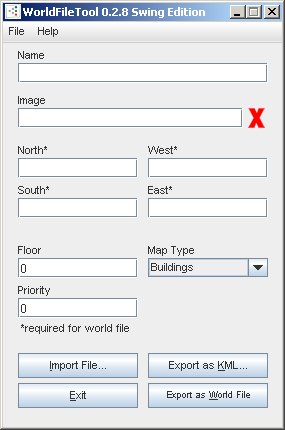WorldFileTool: Unterschied zwischen den Versionen
Stefan (Diskussion | Beiträge) |
Stefan (Diskussion | Beiträge) |
||
| Zeile 24: | Zeile 24: | ||
Now you can use the image e.g. in [[GIS]] tools like [[UMN Mapserver]] (based on the world file) or in [[IndoorWPS Locator]] (based on the KML). | Now you can use the image e.g. in [[GIS]] tools like [[UMN Mapserver]] (based on the world file) or in [[IndoorWPS Locator]] (based on the KML). | ||
| + | |||
| + | For bugs and feature requests see [http://sifsv002.hsr.ch/worldfiletool Developer's Wiki]. | ||
== How to transform a World file into WGS84? == | == How to transform a World file into WGS84? == | ||
Version vom 8. Oktober 2008, 00:20 Uhr
A metadata management tool for georeferenced images.
See also World file, IndoorWPS_Locator, Google Earth, DesktopWMS.
Inhaltsverzeichnis
About...
The WorldFileTool is an interactive tool and a library to georeference images using free and open source software. Both, the World file and the KML file ('GroundOverlay' tag), enable GIS programs to read georeferenced images.
Features
- Loads, edits and saves KML with its linked image
- If needed, rotates an image to be north aligned and saves it back (and rotating raster images is NOT trivial and at least time consuming!)
- Supports following graphic file formats: jpg, tiff, png, gif
- Imports and exports a World file with its corresponding image
Usage
Prepare the image. In order to minimize the system strain, keep the image size smaller than 2000 x 2000 pixels.
- Open Google Earth, use "Add Image Overlay", save it and export it as .kml in a local directory.
- Start WorldFileTool, import KML and export it either again KML or as world file.
- Done.
Now you can use the image e.g. in GIS tools like UMN Mapserver (based on the world file) or in IndoorWPS Locator (based on the KML).
For bugs and feature requests see Developer's Wiki.
How to transform a World file into WGS84?
The WorldFileTool currently can't reproject coordinates, e.g. from local to other CRSs. But Google Earth for example expects image overlays unprojected with lat/long extents.
Use gdalwarp (see GDAL) to convert each world file into an unprojected GeoTiff, and then gdal_translate to produce a jpeg compatible with Google Earth, along with another worldfile listing in lat/lon.
% gdalwarp -s_srs EPSG:21781 -t_srs EPSG:4326 switzerland.jpg switzerland_wgs84.tif % gdal_translate -outsize 13% 13% -of JPEG -co WORLDFILE=YES switzerland_wgs84.tif switzerland_wgs84.jpg
Download
- Download: WorldFileTool
- SVN: http://sifsv002.hsr.ch/svn/worldfiletool (Browse source on SVN)
- Bug Report
- Full deliverable contains Java (inc. Javadoc), Swing, SWT and test cases (JUnit).
Other software to convert World files
- ArcGIS
- The TatukGIS Viewer can open a raster image file in several different formats (JPG, BMP, PNG, TIF, ECW, SID, JP2), use the world file to georeference it, and then export it to the GeoTiff format with the georeferencing data embedded in it.
- See also http://freegeographytools.com
